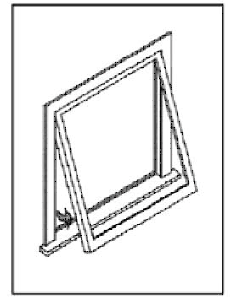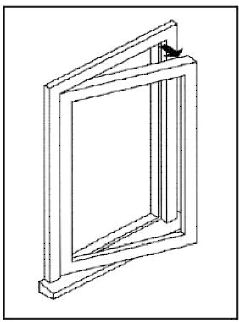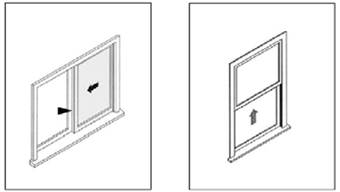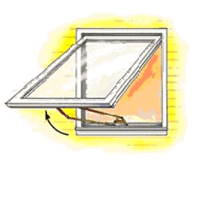Using a window as an escape route in a fire has saved many lives. In as little as 3 minutes the heat created by a small fire can:
- cause everything in the room to burst into flames (called a flashover)
- create clouds of thick black smoke
- melt clothes and burn the lungs
- create poisonous gases (like carbon monoxide and ammonia) and other irritants that can affect your eyes, nose, throat, and lungs
This is why it is important to have a
fire escape plan:
- Have a home escape plan and make sure that everyone knows what to do.
- Practice the pre-planned fire drill at least twice a year.
- Have two ways to get out of every room.
- Decide on a meeting place outside the home.
What should I know about using a window as an escape route?
Make sure the window easily opens all the way:
- Fix any problems causing the window to stick.
- Fix any parts that are broken.
Make sure nothing prevents the window from opening:
- Check exterior fasteners (like clips, nails, or screws).
- Make sure there is enough room if the basement window opens into a window well.
- Make sure that the handle isn’t so big that it gets in the way of the opening.
Make sure the opening is big enough when the window is open all the way:
- Just because the windows opens easily or all the way, doesn’t mean that there is enough room for a person to go through it.
You don’t want to have to break a window in an emergency because the window doesn’t open or the opening isn’t big enough. You can cut yourself badly crawling over broken glass.
Make sure the window isn’t too high to use as an exit:
- The window sill should not be higher than 1.5 meters above the floor.
- Make it easier to get out of a basement window by making it easier to reach the window. For example, by installing built-in furniture under the window.
If children are expected to escape through a bedroom window on their own make sure they are taught how to open the window and remove or release any screens or bars. Make sure they show you that they know how to open the window. Home fire drills should include practicing how to escape through the window. For those people who are too young or can’t escape on their own through a window, think about using more smoke alarms in the bedroom. You could also move their bedroom to the first floor so it is easier to get them out.
Can all windows be used as an escape?
Windows should be easy to use and easy to open. Windows that take more than one step to open should not be used as an escape route.
Windows that need several steps to open them include:
- slide-and-tilt (the glass can be flipped to open into a room)
- pop-up
- ones that need to be unclipped from more than one place
- detach and remove windows
Don’t use windows if the hardware needed to open or release the window is hidden. The user would:
- have to know where the hardware is hidden (you can easily forget during the stress of an emergency)
- have to know how the hardware works
- have to be able to operate it (for example, a person with weak hands may have trouble holding on to the hardware)
Quick-release hardware, meant to make it easier to release the hardware, could also not allow the window to stay open, making it harder to get out.
Hardware used to latch the window (for security or to shut it tightly) should be in plain slight and easy to use.
Insect screens, security bars, grilles, etc. should be easy to remove or open. You should be able to open a security bar from the inside without any tools or extra steps.
What windows can be used?
| Can Use | Should not Use |
- Full Vent In-Swing Awning
- Casement
- Horizontal or Vertical Slider
| |
Can Use

| Full Vent In-Swing Awning - Full vent in-swing awning windows swing open at or near the top of the frame.
- The window swings in, towards the user. If the window opens into a window well, you should be able to open the window all the way without hitting the window well. You should also have enough room to get out the window into the well area.
- It doesn’t restrict the clearance when going into a window well.
- A catch has to be used to hold the window open.
|

| Casement - A casement window opens from the side.
- The opening hardware is usually installed at the bottom of the window.
- This hardware can block an escape. Make sure you measure the opening just to the hardware so that you know how big the opening really is.
- Casement windows usually have latches opposite the hinge. Children should be able to reach these latches if they are expected to escape on their own.
- Hinge hardware may allow the window to pivot around an axis at or near the jamb. The opening must be large enough, even with the opening hardware blocking the opening and the window fully open.
|

| Horizontal and Slider Windows - Horizontal and vertical slider windows are commonly used in new homes.
- Measure the size of the unobstructed opening when the window is in the fully open position.
|
Should Not Use

| Hopper - A hopper window swings open at or near the bottom of the frame.
- A latch holds it closed.
- It usually doesn’t come with an opening operator, so that it can swing open freely or be held partially open with a catch.
- With the way a hopper window opens, a person would have to crawl over the pane of glass to escape.
- Hopper windows are not usually used in bedrooms.
|

| Awning - An awning window swings open at or near the top of the frame.
- The opening hardware for an awning window usually extends between the middle of the sill and the middle of the window sash.
- This means that it will block a person trying to escape through the window.
- Awning windows are usually not a good way to escape.
|
Other Things to Think About
Ice build-up that prevents or restricts the opening of a window is a concern with any type of window.
If foundation concrete has to be cut to fit a larger window, you may need a building permit and/ or an engineer’s design. Contact your municipal Planning and Development department.
